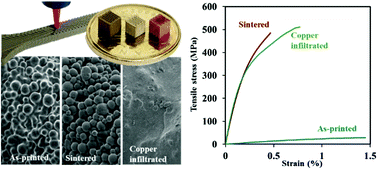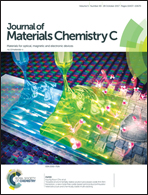Solvent-cast based metal 3D printing and secondary metallic infiltration†
Abstract
Affordable 3D printing methods are needed for the development of high performance metallic structures and devices. We develop a method to fabricate dense metallic structures by combining a room temperature 3D printing and subsequent heat-treatments: sintering and secondary metallic infiltration. The high flexibility of this method enables the fabrication of customized 3D structures, such as fully-filled, porous, interlocked and overhung structures. These geometries are printed using a highly concentrated metallic ink (metallic load up to 98 wt%) consisting of highly alloyed steel (HAS) microparticles, polylactic acid (PLA) and dichloromethane (DCM). In order to improve the mechanical properties and the electrical conductivity, the as-printed structures are sintered and infiltrated by copper in a furnace protected by a mixture of H2 and Ar. The filament porosity of the copper infiltrated samples is as low as 0.2%. Mechanical testing and electrical conductivity measurement on the copper infiltrated structures reveal that the Young's modulus reaches up to ∼195 GPa and the electrical conductivity is as high as 1.42 × 106 S m−1. Our method enables the simple fabrication of high performance metallic structures which could open up new technological applications where cost is an important factor.



 Please wait while we load your content...
Please wait while we load your content...